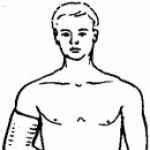One of the first topics studied in an algebra course is abbreviated multiplication formulas. In grade 7, they are used in the simplest situations, where you need to recognize one of the formulas in an expression and factor a polynomial or, conversely, quickly square or cube a sum or difference. In the future, FSU is used to quickly solve inequalities and equations and even to calculate some numerical expressions without a calculator.
What does a list of formulas look like?
There are 7 basic formulas that allow you to quickly multiply polynomials in brackets.
Sometimes this list also includes an expansion for the fourth degree, which follows from the presented identities and has the form:
a⁴ — b⁴ = (a - b)(a + b)(a² + b²).
All equalities have a pair (sum - difference), except the difference of squares. The formula for the sum of squares is not given.
The remaining equalities are easy to remember:

It should be remembered that FSUs work in any case and for any values a And b: these can be either arbitrary numbers or integer expressions.
In a situation where you suddenly can’t remember which sign is in front of a particular term in the formula, you can open the brackets and get the same result as after using the formula. For example, if a problem arose when applying the difference cube FSU, you need to write down the original expression and perform multiplication one by one:
(a - b)³ = (a - b)(a - b)(a - b) = (a² - ab - ab + b²)(a - b) = a³ - a²b - a²b + ab² - a²b + ab² + ab² - b³ = a³ - 3a²b + 3ab² - b³.
As a result, after bringing all similar terms, the same polynomial as in the table was obtained. The same manipulations can be carried out with all other FSUs.

Application of FSU to solve equations
For example, you need to solve an equation containing polynomial of degree 3:
x³ + 3x² + 3x + 1 = 0.
IN school curriculum are not considered universal techniques to solve cubic equations, and such tasks are most often solved in more simple methods(for example, by factorization). If we notice that the left side of the identity resembles the cube of a sum, then the equation can be written in a simpler form:
(x + 1)³ = 0.
The root of such an equation is calculated orally: x = -1.
Inequalities are solved in a similar way. For example, you can solve the inequality x³ – 6x² + 9x > 0.

First of all, you need to factor the expression. First you need to bracket x. After this, note that the expression in parentheses can be converted to the square of the difference.
Then you need to find the points at which the expression takes zero values and mark them on the number line. In a particular case, these will be 0 and 3. Then, using the interval method, determine in which intervals x will correspond to the inequality condition.
FSUs may be useful when performing some calculations without the help of a calculator:
703² - 203² = (703 + 203)(703 - 203) = 906 ∙ 500 = 453000.
Additionally, by factoring expressions, you can easily reduce fractions and simplify various algebraic expressions.
Examples of problems for grades 7-8
In conclusion, we will analyze and solve two tasks on the use of abbreviated multiplication formulas in algebra.
Task 1. Simplify the expression:
(m + 3)² + (3m + 1)(3m - 1) - 2m (5m + 3).
Solution. The condition of the task requires simplifying the expression, i.e. opening the parentheses, performing the operations of multiplication and exponentiation, and also bringing all similar terms. Let us conditionally divide the expression into three parts (according to the number of terms) and open the brackets one by one, using FSU where possible.
- (m + 3)² = m² + 6m + 9(sum square);
- (3m + 1)(3m - 1) = 9m² – 1(difference of squares);
- In the last term you need to multiply: 2m (5m + 3) = 10m² + 6m.

Let's substitute the results obtained into the original expression:
(m² + 6m + 9) + (9m² – 1) - (10m² + 6m).
Taking into account the signs, we will open the brackets and present similar terms:
m² + 6m + 9 + 9m² 1 - 10m² – 6m = 8.
Problem 2. Solve an equation containing the unknown k to the 5th power:
k⁵ + 4k⁴ + 4k³ – 4k² – 4k = k³.
Solution. In this case, it is necessary to use the FSU and the grouping method. It is necessary to move the last and penultimate terms to the right side of the identity.
k⁵ + 4k⁴ + 4k³ = k³ + 4k² + 4k.
The common factor is derived from the right and left sides (k² + 4k +4):
k³(k² + 4k + 4) = k (k² + 4k + 4).
Everything is transferred to the left side of the equation so that 0 remains on the right:
k³(k² + 4k + 4) - k (k² + 4k + 4) = 0.
Again it is necessary to take out the common factor:
(k³ - k)(k² + 4k + 4) = 0.
From the first factor obtained we can derive k. According to the short multiplication formula, the second factor will be identically equal to (k+2)²:
k (k² - 1)(k + 2)² = 0.
Using the difference of squares formula:
k (k - 1)(k + 1)(k + 2)² = 0.
Since a product is equal to 0 if at least one of its factors is zero, finding all the roots of the equation is not difficult:
- k = 0;
- k - 1 = 0; k = 1;
- k + 1 = 0; k = -1;
- (k + 2)² = 0; k = -2.
Based illustrative examples You can understand how to remember formulas, their differences, and also solve several practical problems using FSU. The tasks are simple and there should be no difficulties in completing them.
Abbreviated expression formulas are very often used in practice, so it is advisable to learn them all by heart. Until this moment, it will serve us faithfully, which we recommend printing out and keeping before your eyes at all times:
The first four formulas from the compiled table of abbreviated multiplication formulas allow you to square and cube the sum or difference of two expressions. The fifth is intended for briefly multiplying the difference and the sum of two expressions. And the sixth and seventh formulas are used to multiply the sum of two expressions a and b by their incomplete square of the difference (this is what an expression of the form a 2 −a b+b 2 is called) and the difference of two expressions a and b by the incomplete square of their sum (a 2 + a·b+b 2 ) respectively.
It is worth noting separately that each equality in the table is an identity. This explains why abbreviated multiplication formulas are also called abbreviated multiplication identities.
When solving examples, especially in which the polynomial is factorized, the FSU is often used in the form with the left and right sides swapped:

The last three identities in the table have their own names. The formula a 2 −b 2 =(a−b)·(a+b) is called difference of squares formula, a 3 +b 3 =(a+b)·(a 2 −a·b+b 2) - sum of cubes formula, A a 3 −b 3 =(a−b)·(a 2 +a·b+b 2) - difference of cubes formula. Please note that we did not name the corresponding formulas with rearranged parts from the previous table.
Additional formulas
It wouldn’t hurt to add a few more identities to the table of abbreviated multiplication formulas.
Areas of application of abbreviated multiplication formulas (FSU) and examples
The main purpose of abbreviated multiplication formulas (fsu) is explained by their name, that is, it consists in briefly multiplying expressions. However, the scope of application of FSU is much wider, and is not limited to short multiplication. Let's list the main directions.
Undoubtedly, the central application of the abbreviated multiplication formula was found in performing identical transformations of expressions. Most often these formulas are used in the process simplifying expressions.
Example.
Simplify the expression 9·y−(1+3·y) 2 .
Solution.
In this expression, squaring can be performed abbreviated, we have 9 y−(1+3 y) 2 =9 y−(1 2 +2 1 3 y+(3 y) 2). All that remains is to open the brackets and bring similar terms: 9 y−(1 2 +2 1 3 y+(3 y) 2)= 9·y−1−6·y−9·y 2 =3·y−1−9·y 2.
Maintaining your privacy is important to us. For this reason, we have developed a Privacy Policy that describes how we use and store your information. Please review our privacy practices and let us know if you have any questions.
Collection and use of personal information
Personal information refers to data that can be used to identify or contact a specific person.
You may be asked to provide your personal information at any time when you contact us.
Below are some examples of the types of personal information we may collect and how we may use such information.
What personal information do we collect:
- When you submit an application on the site, we may collect various information, including your name, telephone number, address Email etc.
How we use your personal information:
- Collected by us personal information allows us to contact you and inform you about unique offers, promotions and other events and upcoming events.
- From time to time, we may use your personal information to send important notices and communications.
- We may also use personal information for internal purposes, such as conducting audits, data analysis and various research in order to improve the services we provide and provide you with recommendations regarding our services.
- If you participate in a prize draw, contest or similar promotion, we may use the information you provide to administer such programs.
Disclosure of information to third parties
We do not disclose the information received from you to third parties.
Exceptions:
- If necessary, in accordance with the law, judicial procedure, V trial, and/or based on public requests or requests from government agencies on the territory of the Russian Federation - disclose your personal information. We may also disclose information about you if we determine that such disclosure is necessary or appropriate for security, law enforcement, or other public importance purposes.
- In the event of a reorganization, merger, or sale, we may transfer the personal information we collect to the applicable successor third party.
Protection of personal information
We take precautions - including administrative, technical and physical - to protect your personal information from loss, theft, and misuse, as well as unauthorized access, disclosure, alteration and destruction.
Respecting your privacy at the company level
To ensure that your personal information is secure, we communicate privacy and security standards to our employees and strictly enforce privacy practices.
Maintaining your privacy is important to us. For this reason, we have developed a Privacy Policy that describes how we use and store your information. Please review our privacy practices and let us know if you have any questions.
Collection and use of personal information
Personal information refers to data that can be used to identify or contact a specific person.
You may be asked to provide your personal information at any time when you contact us.
Below are some examples of the types of personal information we may collect and how we may use such information.
What personal information do we collect:
- When you submit an application on the site, we may collect various information, including your name, phone number, email address, etc.
How we use your personal information:
- The personal information we collect allows us to contact you with unique offers, promotions and other events and upcoming events.
- From time to time, we may use your personal information to send important notices and communications.
- We may also use personal information for internal purposes, such as conducting audits, data analysis and various research in order to improve the services we provide and provide you with recommendations regarding our services.
- If you participate in a prize draw, contest or similar promotion, we may use the information you provide to administer such programs.
Disclosure of information to third parties
We do not disclose the information received from you to third parties.
Exceptions:
- If necessary - in accordance with the law, judicial procedure, in legal proceedings, and/or on the basis of public requests or requests from government authorities in the territory of the Russian Federation - to disclose your personal information. We may also disclose information about you if we determine that such disclosure is necessary or appropriate for security, law enforcement, or other public importance purposes.
- In the event of a reorganization, merger, or sale, we may transfer the personal information we collect to the applicable successor third party.
Protection of personal information
We take precautions - including administrative, technical and physical - to protect your personal information from loss, theft, and misuse, as well as unauthorized access, disclosure, alteration and destruction.
Respecting your privacy at the company level
To ensure that your personal information is secure, we communicate privacy and security standards to our employees and strictly enforce privacy practices.
Mathematical expressions (formulas) abbreviated multiplication(square of sum and difference, cube of sum and difference, difference of squares, sum and difference of cubes) are extremely irreplaceable in many areas of the exact sciences. These 7 symbolic notations are invaluable for simplifying expressions, solving equations, multiplying polynomials, reducing fractions, solving integrals, and much more. This means it will be very useful to understand how they are obtained, why they are needed, and most importantly, how to remember them and then apply them. Then applying abbreviated multiplication formulas in practice the most difficult thing will be to see what is X and what do you have. Obviously, there are no restrictions for a And b no, which means it can be any numeric or alphabetic expression.
And so here they are:
First x 2 - at 2 = (x - y) (x+y).To calculate difference of squares two expressions, you need to multiply the differences of these expressions by their sums.
Second (x + y) 2 = x 2 + 2xy + y 2. To find square of the sum two expressions, you need to add to the square of the first expression the double product of the first expression and the second plus the square of the second expression.
Third (x - y) 2 = x 2 - 2xy + y 2. To calculate squared difference two expressions, you need to subtract from the square of the first expression twice the product of the first expression by the second plus the square of the second expression.
Fourth (x + y) 3 = x 3 + 3x 2 y + 3xy 2 + at 3. To calculate cube of sum two expressions, you need to add to the cube of the first expression the triple product of the square of the first expression by the second plus the triple product of the first expression by the square of the second plus the cube of the second expression.
Fifth (x - y) 3 = x 3 - 3x 2 y + 3xy 2 - at 3. To calculate difference cube two expressions, it is necessary to subtract from the cube of the first expression the triple product of the square of the first expression by the second plus the triple product of the first expression by the square of the second minus the cube of the second expression.
Sixth x 3 + y 3 = (x + y) (x 2 - xy + y 2) To calculate sum of cubes two expressions, you need to multiply the sums of the first and second expressions by the incomplete square of the difference of these expressions.
Seventh x 3 - at 3 = (x - y) (x 2 + xy + y 2) To perform the calculation differences of cubes two expressions, you need to multiply the difference of the first and second expressions by the incomplete square of the sum of these expressions.
It is not difficult to remember that all formulas are used to perform calculations in the opposite direction (from right to left).
The existence of these patterns was known about 4 thousand years ago. They were widely used by the inhabitants of ancient Babylon and Egypt. But in those eras they were expressed verbally or geometrically and did not use letters in calculations.
Let's sort it out square sum proof(a + b) 2 = a 2 +2ab +b 2.
First this mathematical pattern Proved by the ancient Greek scientist Euclid, who worked in Alexandria in the 3rd century BC, he used a geometric method to prove the formula, since the scientists of ancient Hellas did not use letters to denote numbers. They everywhere used not “a 2”, but “a square on a segment a”, not “ab”, but “a rectangle enclosed between segments a and b”.




